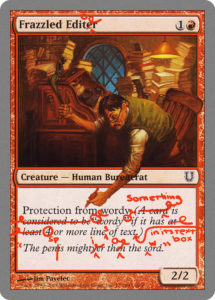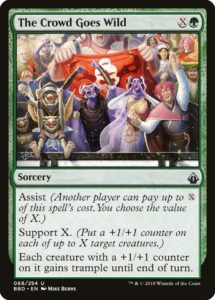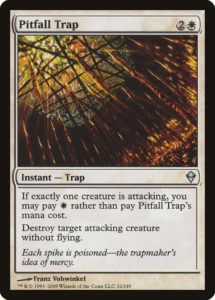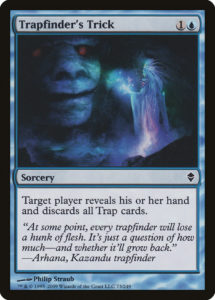To many, Magic is the greatest game in the world. However, it is by no means a perfect game. Magic is complicated, it has all the benefits and downsides of variance, it affords a wide variety of not only playstyles but actual games you can play with the components, but it also affords a variety of price ranges. That said, Magic’s greatest weakness is right there at the beginning: it can be a very difficult game to learn. Without an influx of new players, attrition will inevitably kill any game, Magic included. The fact that Magic is going so incredibly strong when it has this pointed weakness speaks to just how excellent it is.
Today I’d like to maybe put a tiny, tiny dent in Magic’s abstruseness (the quality of being difficult to learn—yes, I looked it up because sometimes you need the right word). Today, let’s talk about how to teach games to other people. Please note, while we’ll focus on Magic, these lessons are applicable to basically any game. Since we’ve got such a broad focus, this article will be readable for people with even a passing familiarity with Magic.
Who am I?
Yeah, who does this guy think he is? What does he know?
I definitely don’t have all the answers, but I have been doing this for some time. I am a game designer. I get paid to provide fun, entertaining experiences for players. These experiences have to teach themselves, because I can’t be there to facilitate the best play experience for my players. Moreover, because I mostly design board games, I can’t rely on a computer to properly tutorialize my players. Accordingly, I think a lot about the kinds of people who will engage with my work, about what their first impressions could be, and how I can make them as enjoyable as possible.
I design for Kingdom Death: Monster, a very complicated miniatures game. I have led our demo teams for the past four years, which has me constantly and directly engaging with the problem of how best to introduce people to a complex system in a brief and fun way. I’ve also taught over a hundred people how to play Magic since 1994, so I have some familiar with the issues particular to Magic. I certainly don’t know everything, but I do know some things.
Who is your Audience?
The first thing to consider isn’t what game you’re teaching, but who wants to learn. Do you know this person? If so, do you know what they like, or what similar games they’ve played? Are they familiar with this game or are they coming to it with no prior knowledge? Can you find out why they want to learn? Maybe they’re curious about Magic and want to gently dip their toe in, or maybe they’re a competitive Street Fighter player who wants to learn why their other competitive friends love Magic.
There is no one-size-fits-all to education. Your students won’t have your brain or life experiences and might not share your taste, or even like the same things about the game that you do. It’s essential to recognize that different people have different needs which require different approaches. This doesn’t mean you need to plan a variety of different lessons, it just means you should try to understand their perspective and plan to course-correct when they hook onto something that you don’t, or when they might not be as excited about your favorite thing as you are.
Much of the time, you’re teaching someone brand new, so we’ll focus on that. It’s also the easiest experience to go awry.
The Pitfall of Comprehension
Perhaps the most common mistake in teaching a game to a newcomer is trying to teach them how to play. This is fairly counterintuitive—what are we teaching them if not how to play the game? You want them to know how to play without you, but that is never the immediate goal. People are smart. Give them a reason to care about the game, provide them a safe framework within which to experiment and fail, gift them with a few tools, and they will teach themselves how to play far more quickly and effectively than you could ever teach them.
Your first goal is to demonstrate the experience of what playing the game is like. If they enjoy that, they’ll probably like the game and want to play again (that’s your second goal). If they don’t like that, well, they probably won’t enjoy the game, either, and you’ve just saved both of you some time and frustration. This can be painful for enfranchised players. It’s hard to imagine someone falling in love with Magic’s rich complexity when so much of it is stripped out of a Welcome Deck or an Arena tutorial. On the other side, it’s hard for a newcomer to appreciate that complexity when they’re still learning to tap and untap their lands, understand how power and toughness work, recognize that damage wears off (but not immediately) and that you can only play lands or most spells at certain times, all while juggling seven permanents and four cards in hand.
Comprehension is a medium-term goal. Some people will immediately and intuitively understand the game, but the vast majority will take more varied amounts of time. Give them a fun first experience that leaves them wanting more and they’ll play again. Give them an overwhelming cavalcade of rules and you could accidentally snuff out a matchstick before it kindles a lifelong love.
Tips & Tricks
Wait, that’s it? One lesson?
Yup! We’ve covered the central lesson of teaching games as well as the most common mistake. Now that you’re on board, let’s share some secrets to bring your teaching to the next level.
Find the fun
What are the coolest parts of this game? Find a way to make that moment happen. This is why Welcome Decks include awesome, expensive rares. It’s also why they include a variety of cards, since each game being different is perhaps variance’s greatest gift to Magic.
What is absolutely essential?
What parts of the game are core to the experience, and what is not? Trim the things that can wait until later. This is why Welcome Decks don’t include all card types and are only thirty, highly curated cards. When we demo Kingdom Death at Gen Con (which we’ll be doing this week), we don’t showcase the Settlement Phase where you build a fledgling settlement into a civilization (my favorite part of the game), we showcase the Showdown Phase where you fight monsters (which both shows better and is easier to understand).
Even the odds
People tend not to like it when someone is obviously going easy on them, especially in competitive games. So instead of just “playing dumb,” give yourself some handicaps that will make winning difficult but allow you to play to the best of your ability. When I taught my girlfriend how to play Magic, I applied some rules that made victory difficult, but also enabled me to not go easy on her:
- I cannot play a card until she does. (I want her to experience it first.)
- I cannot play a creature until she has dealt combat damage to me. (I want her to learn attacking and how combat damage works before she also has to learn about blocking.)
- I can only play five spells. (I have to absolutely maximize every decision I make because my resources are so finite, while she has far more resources with which to work with. It’s a fun puzzle that keeps me engaged but also muzzles me.)
Keep it Short
You want the game to end before it gets stale. When the really cool moment happens, or someone starts to win, let that happen. If you’ve ever wondered why great some great TV shows end so suddenly, it’s because they’re ending on a high note, rather than well after they’ve peaked and gone downhill. This is another reason why Welcome Decks only have thirty cards (and have so many creatures)—it’s impossible for the game to go on for very long. When I design demos, I aim for them to be 15-30 minutes, even though a single session of Kingdom Death can take hours—that’s too long for people to pay attention and waaaay too much work for me and my team.
Teach Experiences, Never Strategy
People enjoy working out their own strategies. Let them. Equip them with the basic knowledge of what they need to play the game and allow them to learn the basic heuristics (rules of thumb) on their own. Telling players what to do only removes their agency in an obvious and frustrating sense; carefully curating a demo or lesson to maximize their experience can remove their agency in a subtle and beneficial manner.
Winning
Winning is fun, even for those of us who aren’t hyper-competitive. When I teach Magic, I tend to try to set up my student for victory (even if I have to add additional handicaps or set up their library to get them out of mana screw/flood). Winning the game is a feather in their cap that makes it more likely they’ll have fun and come back for more.
On the flipside, when I design demos for Kingdom Death, I aim for players to win no more than 50% of the time. So much of the experience of KD is engaging in impossible-seeming cooperative fights against a system stacked against them. By setting them up for a triumphant, collective failure when victory is so close, I do a better job of demonstrating the game-experience than I ever would by ensuring triumph. Sometimes, you want your players to win their first game every time; sometimes, losing is better. As said before, find the fun and try to make it happen.
And that’s how you teach someone how to play a game. And, as always, thanks for reading.
—Zachary Barash is a New York City-based game designer and the commissioner of Team Draft League. He designs for Kingdom Death: Monster, has a Game Design MFA from the NYU Game Center, and does freelance game design. When the stars align, he streams Magic (but the stars align way less often than he’d like).
His favorite card of the month is Tajuru Pathwarden. It’s a unique combination of numbers that’d never been done before in quite that way and was one of a few cards that turned green from the worst color in Battle for Zendikar into one of the stronger colors in Oath of the Gatewatch. It can be really nice when a french vanilla creature does a lot of work.





